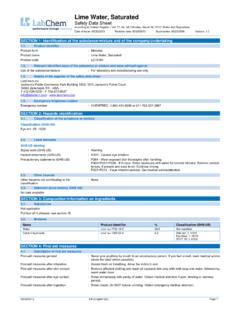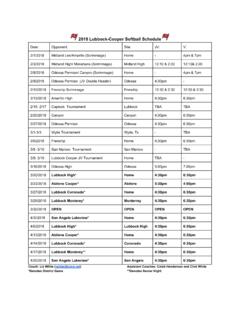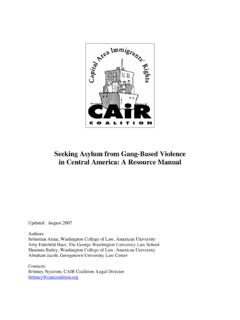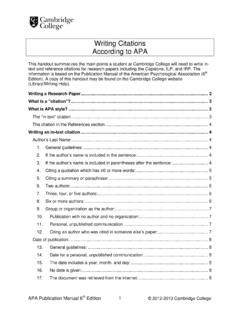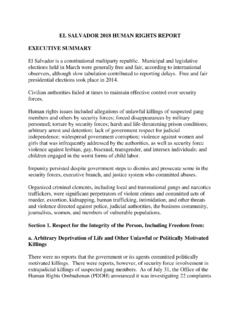Transcription of CONTENTS
1 CONTENTSTITLE PAGEDEDICATIONMAPPROLOGUE1. THE BOY LEFT BEHIND2. SEEKING MERCY3. FACING THE BEAST4. GIFTS AND FAITH5. ON THE BORDERPHOTO INSERTS6. A DARK RIVER, PERHAPS A NEW LIFE7. THE GIRL LEFT BEHINDAFTERWORD: WOMEN, CHILDREN, AND THE IMMIGRATION DEBATEEPILOGUENOTESACKNOWLEDGMENTSABOUT THE AUTHORPRAISE FOR ENRIQUE S JOURNEYCOPYRIGHTTo my husband, BillPROLOGUEIt is Friday morning, 8 I hear a key turn in the front-door lock of my Los Angeles home. Mar adel Carmen Ferrez, who cleans my house every other week, opens the door. She walks into is petite, intelligent, and works at lightning speed. At this early hour I am usually in afrenzy to get out the door and rush to my office. But on days when Carmen arrives, she and I shiftgears. Carmen loiters in the kitchen, tidying things. I circle around her, picking up shoes, newspapers,socks trying to give her a fighting chance at cleaning the floors. The ritual allows us to be in thesame room and this morning in 1997, I lean on one side of the kitchen island.
2 Carmen leans on the other is a question, she says, that she has been itching to ask. Mrs. Sonia, are you ever going to havea baby? I m not sure, I tell her. Carmen has a young son she sometimes brings to watch television while sheworks. Does she want more children? I , always laughing and chatty, is suddenly silent. She stares awkwardly down at the kitchencounter. Then, quietly, she tells me about four other children I never knew existed. These children two sons and two daughters are far away, Carmen says, in Guatemala. She left them there when sheventured north as a single mother to work in the United has been separated from them for twelve youngest daughter, Carmen says, was just a year old when she left. She has experienced heroldest boy, Minor, grow up by listening to the deepening timbre of his voice on the telephone. AsCarmen unravels the story, she begins to years? I react with disbelief. How can a mother leave her children and travel more than twothousand miles away, not knowing when or if she will ever see them again?
3 What drove her to dothis?Carmen dries her tears and explains. Her husband left her for another woman. She worked hard butdidn t earn enough to feed four children. They would ask me for food, and I didn t have it. Manynights, they went to bed without dinner. She lulled them to sleep with advice on how to quell theirhunger pangs. Sleep facedown so your stomach won t growl so much, Carmen said, gently coaxingthem to turn left for the United States out of love. She hoped she could provide her children an escape fromtheir grinding poverty, a chance to attend school beyond the sixth grade. Carmen brags about theclothes, money, and photos she sends her also acknowledges having made brutal trade-offs. She feels the distance, the lack of affection,when she talks with her children on the telephone. Day after day, as she misses milestones in theirlives, her absence leaves deep wounds. When her oldest daughter has her first menstruation, she isfrightened.
4 She doesn t understand what is happening to her. Why, the girl asks Carmen, were you nothere to explain?Carmen hasn t been able to save enough for a smuggler to bring them to the United States. Besides,she refuses to subject her children to the dangerous journey. During her own 1985 trek north, Carmenwas robbed by her smuggler, who left her without food for three days. Her daughters, she fears, willget raped along the way. Carmen balks at bringing her children into her poor, drug- and crime-infested Los Angeles she clicks the dishwasher on, Carmen, concerned that I might disapprove of her choice, tells methat many immigrant women in Los Angeles from Central America or Mexico are just like her single mothers who left children behind in their home s really incomprehensible, she adds, are middle-class or wealthy working mothers in theUnited States. These women, she says, could tighten their belts, stay at home, spend all their time withtheir children.
5 Instead, they devote most of their waking hours and energy to careers, with little leftfor the children. Why, she asks, with disbelief on her face, would anyone do that?The following year, in 1998, unannounced, Carmen s son Minor sets off to find his left him when he was ten years old. He hitchhikes through Guatemala and Mexico. He begsfor food along the way. He shows up on Carmen s has missed his mother intensely. He could not stand another Christmas or birthday apart. He wastired of what he saw as his mother s excuses for why they could not be together. He had to know: Didshe leave Guatemala because she never truly loved him? How else could he explain why she left?Minor s friends in Guatemala envied the money and presents Carmen sent. You have it all. Goodclothes. Good tennis shoes, they said. Minor answered, I d trade it all for my mother. I never hadsomeone to spoil me. To say: Do this, don t do that, have you eaten?
6 You can never get the love of amother from someone else. Minor tells me about his perilous hitchhiking journey. He was threatened and robbed. Still, he says,he was lucky. Each year, thousands of other children going to find their mothers in the United Statestravel in a much more dangerous way. The children make the journey on top of Mexico s freighttrains. They call it El Tren de la Muerte. The Train of COMMON CHOICEI was struck by the choice mothers face when they leave their children. How do they make such animpossible decision? Among Latinos, where family is all-important, where for women motherhoodis valued far above all else, why are droves of mothers leaving their children? What would I do if Iwere in their shoes? Would I come to the United States, where I could earn much more money andsend cash back to my children? This would mean my sons and daughters could eat more than sugarwater for dinner. They could study past the third grade, maybe even finish high school, go on touniversity classes.
7 Or I could stay by my children s side, relegating another generation to the samemisery and poverty I knew so was also amazed by the dangerous journey these children make to try to be with their kind of desperation, I wondered, pushes children as young as seven years old to set out, alone,through such a hostile landscape with nothing but their wits?The United States is experiencing the largest wave of immigration in its history, a level ofnewcomers that is once again transforming the country. Each year, an estimated 700,000 immigrantsenter the United States illegally. Since 2000, nearly a million additional immigrants annually, onaverage, have arrived legally, or become legal residents. This wave differs in one respect, at least,from the past. Before, when parents came to the United States and left children behind, it was typicallythe fathers, often Mexican guest workers called braceros, and they left their children with theirmothers.
8 In recent decades, the increase in divorce and family disintegration in Latin America has leftmany single mothers without the means to feed and raise their children. The growing ranks of singlemothers paralleled a time when more and more American women began working outside the is an insatiable need in the United States for cheap service and domestic workers. The singleLatin American mothers began migrating in large numbers, leaving their children with grandparents,other relatives, or first wave was in the 1960s and 1970s. Single mothers from a smattering of Caribbeancountries the West Indies, Jamaica, the Dominican Republic headed to New York City, NewEngland, and Florida to work as nannies and in nursing homes. Later, Central American womenflocked to places with the greatest demand: the suburbs of Washington, , Houston, and LosAngeles, where the number of private domestic workers doubled in the s experience is now common.
9 In Los Angeles, a University of Southern California studyshowed, 82 percent of live-in nannies and one in four housecleaners are mothers who still have atleast one child in their home country. A Harvard University study showed that 85 percent of allimmigrant children who eventually end up in the United States spent at least some time separated froma parent in the course of migrating to the United much of the United States, legitimate concerns about immigration and anti-immigrant measureshave had a corrosive side effect: immigrants have been dehumanized and demonized. Their presencein the United States is deemed good or bad, depending on the perspective. Immigrants have beenreduced to cost-benefit by looking at one immigrant his strengths, his courage, his flaws his humanity mighthelp illuminate what too often has been a black-and-white discussion. Perhaps, I start thinking, I couldtake readers on top of these trains and show them what this modern-day immigrant journey is like,especially for children.
10 This, a Los Angeles woman who helps immigrants told me, is theadventure story of the twenty-first century. FEAR AND FLEASFor a good while, I sat on the idea. As a journalist, I love to get inside the action, watch it unfold, takepeople inside worlds they might never otherwise see. I wanted to smell, taste, hear, and feel what thisjourney is like. In order to give a vivid, nuanced account, I knew I would have to travel with childmigrants through Mexico on top of freight thought about starting in Central America and tagging along as one boy tries to reach his motherin the United States. Carmen s son Minor had already explained enough about the trip for me to graspthat this was just shy of nutty. He d told me about the gangsters who rule the train tops, the banditsalong the tracks, the Mexican police who patrol the train stations and rape and rob, about the dangersof losing a leg getting onto and off of moving short, I was there was the issue of marital harmony: I d just finished another project that involved hangingout in dark garages and shacks with speed, heroin, and crack addicts.



